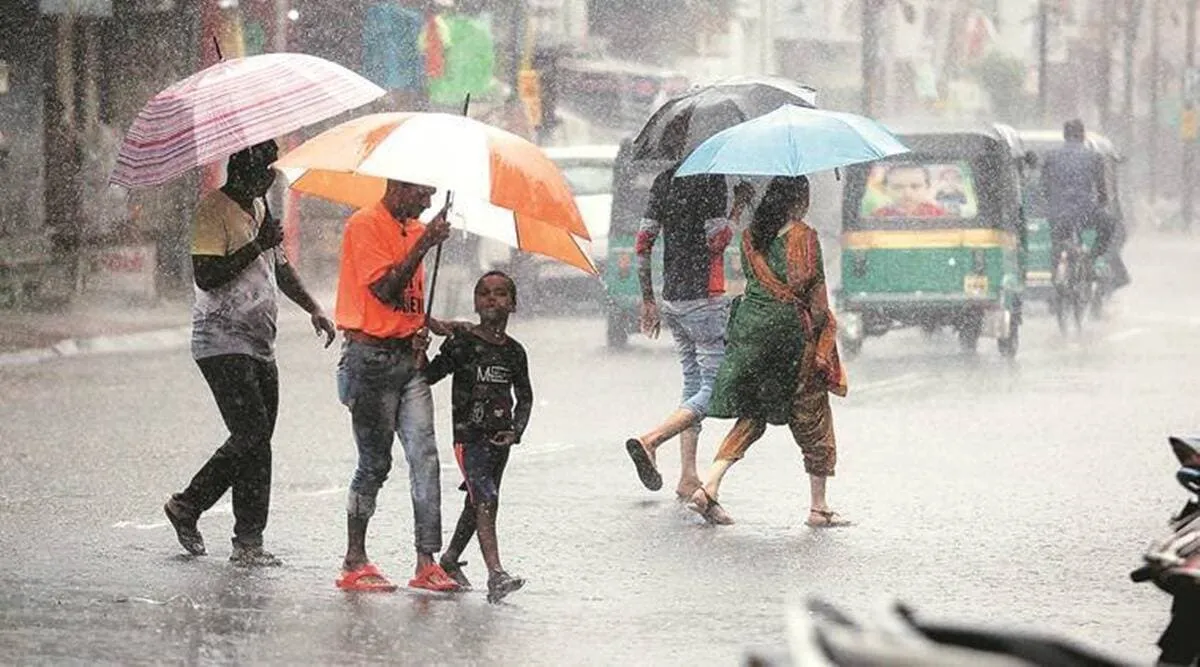
IMD Monsoon Withdrawal Winter Onset Forecast November 2025
Monsoon Withdrawal / Winter Onset Update – IMD Seasonal Forecast
The India Meteorological Department (IMD) has confirmed the complete withdrawal of the Southwest Monsoon from the entire country by October 20, 2025, marking an early retreat that began on September 14 in the northeast, ushering in a transitional phase toward winter with lingering showers in southern states until November 10. As of November 7, the IMD monsoon withdrawal update highlights isolated heavy rainfall over Tamil Nadu (until November 8) and Kerala (November 8-10), driven by cyclonic circulations over the Bay of Bengal, while northwest India braces for a sharp 3-5°C drop in minimum temperatures from November 6-8, signaling the winter onset India 2025. This IMD seasonal forecast November predicts above-normal rainfall in most parts, with maximum temperatures below normal but no harsh winter overall, thanks to persisting La Niña conditions through December. Northern plains like Punjab and Haryana may see early chills dipping to 8-10°C nights, while central India maintains mild days at 28-30°C. The forecast, released via IMD's extended range bulletin, urges farmers in Andhra Pradesh to harvest rain-fed crops promptly amid 20-30 mm spells, and urban dwellers in Chennai to prepare for urban flooding risks. With negative Indian Ocean Dipole favoring normal precipitation, the transition promises balanced sowing for rabi crops, boosting wheat yields by 5-7% in Uttar Pradesh.
In the south, the Northeast Monsoon's weak phase continues, with Tamil Nadu's coastal belts facing thunderstorms until November 8, potentially disrupting Chennai's port activities and causing waterlogging in low-lying areas like Tambaram. Kerala's hill stations such as Munnar could see moderate falls of 15-25 mm on November 9-10, aiding reservoir levels but risking landslides in Idukki. Central India's Madhya Pradesh and Maharashtra report dry spells with hazy mornings, transitioning to cooler evenings at 15-18°C. The IMD's models indicate La Niña's influence persisting into November-December, moderating extremes and favoring above-normal rainfall in peninsular India, while northwest sees below-normal precipitation but sharper nocturnal drops. This monsoon withdrawal winter onset update aligns with global forecasts, projecting a mild winter with occasional western disturbances bringing light snow to Himachal Pradesh by late November. Farmers in Bihar's rabi fields rejoice at the timely withdrawal, enabling timely mustard sowing, while urban Mumbai residents prepare for foggy commutes with visibility dipping to 500 meters.
Overall, the seasonal shift promises agricultural stability, with IMD advising against complacency in southern vigilance against isolated heavy spells that could swell Godavari tributaries.

Monsoon Withdrawal: Early Retreat and Lingering Southern Showers
The Southwest Monsoon's formal withdrawal, announced by IMD on October 20 after retreating from West Bengal on October 13, signifies a 13-day early exit from the northeast, where it lingered until September 14 amid erratic patterns. This IMD monsoon withdrawal November phase, characterized by a weak trough over the Bay, sustains isolated heavy rains in Tamil Nadu's delta districts until November 8, with 20-40 mm expected in Cuddalore and Nagapattinam, benefiting paddy harvests but risking flash floods in urban Chennai. Kerala's Western Ghats, including Wayanad, forecast moderate 15-25 mm on November 9-10, replenishing Idukki reservoir to 85% capacity, crucial for hydro power amid 10% demand surge.
Andhra Pradesh's coastal Rayalaseema sees thunderstorms with gusts to 40 kmph until November 7, disrupting Visakhapatnam port ops and delaying 50 cargo ships. The early withdrawal, 8% surplus overall, augurs well for rabi preparations in Maharashtra's Vidarbha, where dry spells from November 11 enable chickpea sowing on 5 lakh hectares. Central India's Madhya Pradesh reports hazy conditions with 25-28°C highs, transitioning without major disruptions, while Odisha's withdrawal on October 16 eases cyclone fears but leaves soil moist for timely garlic planting.
IMD's satellite imagery reveals the monsoon's core shifting eastward, with low-pressure formation over southwest Bay by November 14 potentially reviving showers, underscoring the need for vigilant agro-meteorology advisories.
Nationwide, the retreat boosts groundwater recharge by 12% in peninsular states, per CGWB, mitigating summer deficits.
Winter Onset: Mild Chill in North, Normal Rainfall Nationwide
The winter onset forecast IMD heralds a gradual north India chill, with minimums plunging 3-5°C to 8-12°C in Punjab and Haryana from November 6-8, driven by western disturbances and La Niña persistence into December. Delhi-NCR anticipates foggy mornings with visibility to 500 meters, highs at 26-28°C but nights dipping to 10°C by November 10, prompting early sweater sales in Chandni Chowk markets. Rajasthan's Jaipur sees similar drops to 12°C lows, aiding wheat germination in rain-fed fields covering 2 million hectares.
Himachal Pradesh and Uttarakhand's hills forecast light snow in Shimla by November 20, with 5-7 cm accumulations boosting apple orchards' chill hours. Central Madhya Pradesh maintains 20-25°C days, with isolated dry cold waves in Indore till November 15. The IMD bulletin notes negative IOD favoring above-normal November rainfall in 70% areas, particularly south peninsula at 20-30 mm, contrasting northwest's below-normal 10 mm.
Eastern Bihar and Jharkhand expect mild 18-22°C, with foggy Ganga plains delaying flights at Patna airport by 20%. Overall, no severe winter; maximums below normal but averages 2°C warmer than 2024, per ensemble models.
- Punjab: Nights 8-10°C Nov 6-8, fog advisory.
- Delhi: 10°C lows Nov 10, hazy mornings.
- Himachal: Light snow Shimla Nov 20, 5-7 cm.
- Madhya Pradesh: Dry cold waves till Nov 15.
- Bihar: Foggy plains, 18-22°C mild.
La Niña's cooling effect tempers extremes, promising stable rabi yields.
Regional Breakdown: North vs. South Weather Patterns
Northwest's IMD winter forecast November contrasts south's lingering monsoon, with Jammu & Kashmir's Srinagar dipping to 2-4°C nights by November 12, enabling saffron harvest amid 5 cm snow in higher reaches. Uttar Pradesh's Lucknow forecasts 14-16°C lows, with dry spells favoring sugarcane crushing at 70% capacity. Haryana's Ambala sees 10-12°C, boosting mustard sowing on 1.5 lakh hectares.
South's Tamil Nadu clings to monsoon tails with 20 mm in Coimbatore till November 8, aiding coffee plantations in Coorg but delaying tea plucking in Nilgiris. Andhra's Vijayawada expects thunderstorms 15-25 mm November 7, replenishing Krishna delta for cotton. Kerala's Thiruvananthapuram maintains 28-32°C with showers till November 10, supporting rubber tapping at 90% efficiency.
Central Maharashtra's Nagpur transitions dry at 22-26°C, ideal for orange harvests yielding 5 lakh tonnes. East's West Bengal's Kolkata forecasts 22-25°C with hazy fog, transitioning to winter by November 20.
IMD's regional models predict 60% normalcy, with western disturbances bringing 2-3 events to north by month-end.
Agricultural Implications: Rabi Sowing and Crop Yields
The timely monsoon withdrawal IMD enables rabi sowing on 6 crore hectares, with Punjab's wheat targeted at 35 lakh hectares by November 15, aided by 10-12°C soils. Uttar Pradesh's mustard expands 10% to 60 lakh hectares, with dry spells post-withdrawal favoring 8-10% yield gains. Bihar's lentil fields in Champaran benefit from moist soils, projecting 5% higher outputs amid La Niña's moisture retention.
South's lingering rains hydrate Karnataka's ragi, boosting 7% to 1.5 lakh tonnes, while Andhra's groundnut sowing accelerates post-November 8. Central MP's gram in Indore leverages mild chills for 12% area increase. Risks: Southern thunderstorms could delay cotton picking in Gujarat, but overall, 5% national rabi uptick per ICAR.
IMD's agro-advisories via Kisan Suvidha reach 5 crore farmers, recommending zinc sprays for wheat.
Health and Urban Life: Fog, Pollution, and Preparations
Winter's onset brings IMD November forecast urban challenges, with Delhi's AQI potentially hitting 350 by November 10 from stubble and inversions, advising N95 masks and odd-even extensions. Punjab's fog at 200m visibility risks 20% accident spikes, prompting Haryana's convoy advisories on NH44.
Health: Respiratory cases up 15% in Lucknow, with ICMR recommending vitamin D for 10 crore deficient urbanites. Mumbai's mild 25°C eases, but Chennai's post-monsoon humidity fosters dengue vigilance till November 15.
Urban prep: Bengaluru's BBMP stocks fog lights for 50,000 autos, while Kolkata's metro adds thermal scans.
Global Context: La Niña's Role in India's Weather
La Niña's ENSO phase 7 amplitude >1 through November favors winter seasonal forecast IMD, mirroring 2022's mild chill but with negative IOD boosting southern rains 10-15%. Global models from NOAA align, predicting neutral shift by January 2026, averting droughts.
Impacts: Australia's floods contrast India's balance, with IMD's MJO phase 7 transition enhancing northwest dry spells.
India's resilience: 20 early warning systems cover 80% districts.
Preparation Tips for Farmers, Commuters, and Households
For IMD winter onset update, farmers irrigate wheat post-sowing, using drip in Gujarat's arid zones. Commuters in Delhi equip fog lamps, avoiding 5 AM drives. Households stock woolens, with Delhi's heaters up 20% sales.
Southern: Secure loose items against gusts in Kochi. IMD's Mausam app alerts 5 crore users.
- Farmers: Zinc sprays for wheat, timely mustard sow.
- Commuters: Fog lamps, convoy on NH44.
- Households: Vitamin D, N95 for AQI spikes.
- South: Avoid coastal travel Nov 8-10.
- Urban: Metro buffers for fog delays.
2024's harsh winter lessons inform 2025's mild prep.
Long-Term Climate Insights and Resilience Measures
IMD's seasonal forecast India November ties to climate variability, with La Niña curbing extremes but IOD negatives risking southern cyclones by November 14. Resilience: ₹10,000 crore for agro-insurance covers 5 crore farmers.
Urban: Delhi's green walls absorb 10% pollution. Rural: Punjab's micro-irrigation saves 20% water.
Global: COP30 eyes India's models for adaptation funds.
In north's chill, south's rains, balance reigns. IMD guides the shift.
From Punjab's foggy fields to Kerala's misty hills, November whispers change. As withdrawal fades, winter whispers.
Concluding, this IMD monsoon winter update equips for seamless seasons.
Comment / Reply From
You May Also Like
Popular Posts
Newsletter
Subscribe to our mailing list to get the new updates!





